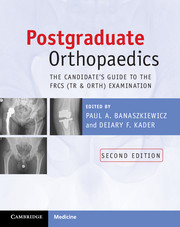Book contents
- Frontmatter
- Contents
- Contributors
- Foreword
- Preface to second edition
- Abbreviations
- Section 1 The FRCS (Tr & Orth) examination
- Section 2 The written paper
- Section 3 The clinicals
- Section 4 The adult elective orthopaedics oral
- Section 5 The hand oral
- Section 6 The paediatric oral
- Section 7 The trauma oral
- Chapter 21 Trauma oral core topics
- Section 8 The basic science oral
- Section 9 Miscellaneous topics
- Index
- References
Chapter 21 - Trauma oral core topics
from Section 7 - The trauma oral
- Frontmatter
- Contents
- Contributors
- Foreword
- Preface to second edition
- Abbreviations
- Section 1 The FRCS (Tr & Orth) examination
- Section 2 The written paper
- Section 3 The clinicals
- Section 4 The adult elective orthopaedics oral
- Section 5 The hand oral
- Section 6 The paediatric oral
- Section 7 The trauma oral
- Chapter 21 Trauma oral core topics
- Section 8 The basic science oral
- Section 9 Miscellaneous topics
- Index
- References
Summary
Introduction
The following pages give guidance on how to approach the trauma viva section of the FRCS (Tr & Orth) examination. The chapter is not exhaustive and the management principles provided should be used with discretion according to the scenario provided. The first few sentences that you say in each topic should be non-controversial and clear. The aim of the candidate should be to show that he or she will be a confident, safe and sound first year consultant in a district general hospital. There is no need to argue with the examiners – there is a fine line between being confident and arrogant. The aim is to secure as high marks as possible to compensate for areas where the candidate has not performed well. However, to get a 7 or even an 8, the candidate has to get 6 first. So, do not jump to quoting papers before talking about management principles.
Hence, the aim of answering in the trauma oral should be a practical approach with first line management and cannot be fobbed off as ‘needs specialist care’. For example, when faced with a cervical spine bifacetal dislocation at 2 am, if the candidate's answer is ‘will need spinal surgeon's care’, then he or she is digging a deep hole from which it becomes difficult to dig themselves out.
- Type
- Chapter
- Information
- Postgraduate OrthopaedicsThe Candidate's Guide to the FRCS (Tr and Orth) Examination, pp. 397 - 432Publisher: Cambridge University PressPrint publication year: 2012



